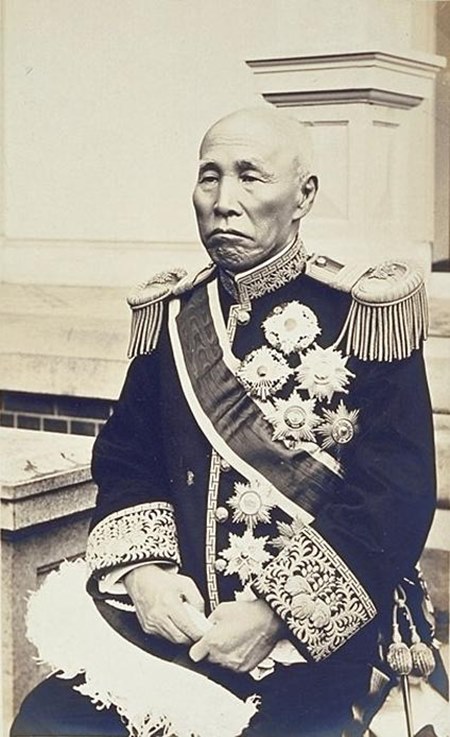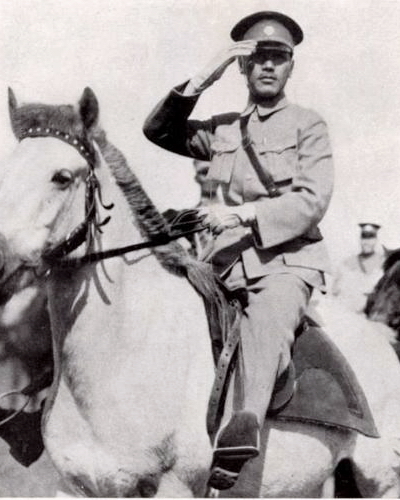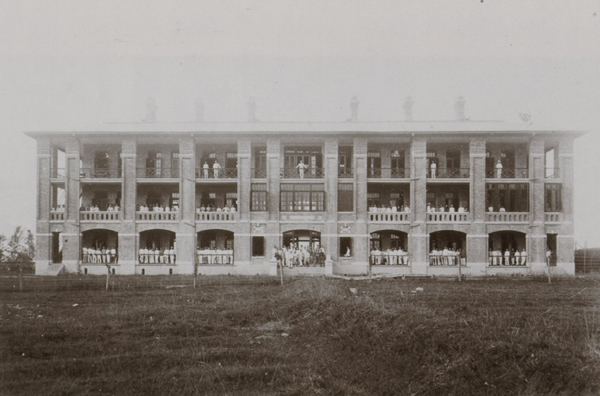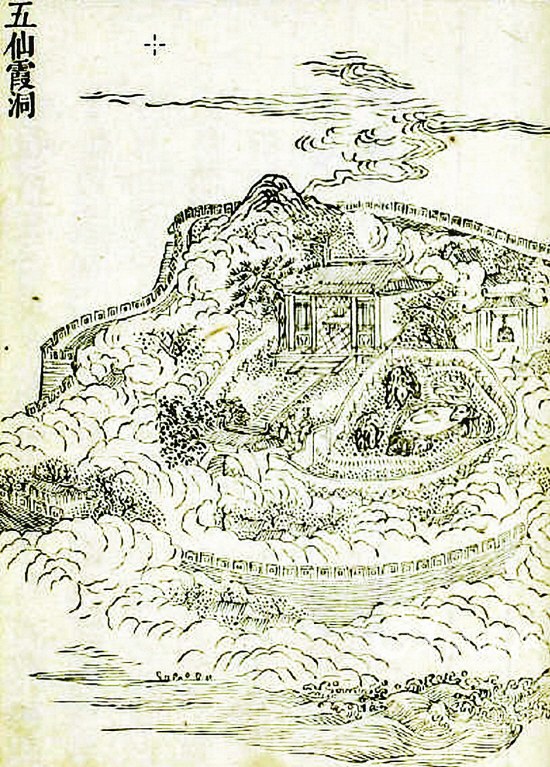|
Liao Chengzhi
Liao Chengzhi (; 25 September 1908 – 10 June 1983) was a Chinese politician. He joined the Communist Party of China in 1928, and rose to the position of director of the Xinhua News Agency; after 1949, he worked in various positions related to foreign affairs, most prominently president of the Beijing Foreign Languages Institute, president of the Sino-Japanese Friendship Society, and Minister of the Office of Overseas Chinese Affairs. Early life Liao was born in the Ōkubo neighbourhood of Tokyo in 1908 to father Liao Zhongkai and mother He Xiangning. His father had wanted to study abroad ever since he was a student at Hong Kong's Queen's College; he left his wife behind in Hong Kong to pursue his studies in Tokyo in January 1903, but she joined him there just three months later. She pursued education there as well, taking time off after young Liao was born, but returning to school just six months later. Based on the excerpt reprinted in Liao was overweight as a child; ... [...More Info...] [...Related Items...] OR: [Wikipedia] [Google] [Baidu] |
Ōkubo, Tokyo
is a neighborhood within Tokyo's Shinjuku ward known for its extensive Korean community.Ryall, JulianBig trouble in Little Korea: spiral of race hate grips Tokyo '' South China Morning Post''. 3 July 2013. Retrieved on 5 July 2013. It is built around Shin-Ōkubo Station and is accessible on the Yamanote Line. Shin-Ōkubo is home to both Korean residents in Japan as well as Korean immigrants, and has seen an upsurge in popularity due to the Hallyu Korean pop-culture boom. In recent years Nepali people have settled in the area and have opened up Nepali restaurants. IORI KAWATE, ''Nikkei'', March 31, ... [...More Info...] [...Related Items...] OR: [Wikipedia] [Google] [Baidu] |
Berlin
Berlin is Capital of Germany, the capital and largest city of Germany, both by area and List of cities in Germany by population, by population. Its more than 3.85 million inhabitants make it the European Union's List of cities in the European Union by population within city limits, most populous city, as measured by population within city limits having gained this status after the United Kingdom's, and thus London's, Brexit, departure from the European Union. Simultaneously, the city is one of the states of Germany, and is the List of German states by area, third smallest state in the country in terms of area. Berlin is surrounded by the state of Brandenburg, and Brandenburg's capital Potsdam is nearby. The urban area of Berlin has a population of over 4.5 million and is therefore the most populous urban area in Germany. The Berlin/Brandenburg Metropolitan Region, Berlin-Brandenburg capital region has around 6.2 million inhabitants and is Germany's second-largest metropolitan reg ... [...More Info...] [...Related Items...] OR: [Wikipedia] [Google] [Baidu] |
Waseda University
, mottoeng = Independence of scholarship , established = 21 October 1882 , type = Private , endowment = , president = Aiji Tanaka , city = Shinjuku , state = Tokyo , country = Japan , students = 47,959 , undergrad = 39,382 , postgrad = 8,577 , faculty = 2,218 full-time3,243 part-time , administrative_staff = 1,257 full-time119 part-time , campus = Urban , former_names = Tōkyō Senmon Gakkō , colors = Maroon , free_label = Athletics , free = 43 varsity teams , affiliations = Universitas 21APRU URA AALAU , mascot = Waseda Bear , website = , footnotes = , address = , logo = , module = , abbreviated as , is a private research university in Shinjuku, Tokyo. Founded in 1882 as the ''Tōkyō Senmon Gakkō'' by Ōkuma Shigenobu, the school was formally renamed Waseda University in 1902. The university has numerous notable alumni, including nine prime ministers of Japan, a number of important figures of Japanese literature, including Haruki Murakami ... [...More Info...] [...Related Items...] OR: [Wikipedia] [Google] [Baidu] |
Shaji Incident
The Shakee Massacre occurred on June 23, 1925 and resulted in over two hundred casualties due to gunfire by British, French and Portuguese forces in Shaji (called ''Shakei'' in Cantonese), Canton, China. On June 21, 1925, workers in Hong Kong and Canton went on strike in support of the May Thirtieth Movement in Shanghai. Two days later, on June 23, over 100,000 people convened in Eastern Jiaochang (today, the Guangdong Provincial People's Stadium), announcing their plans to expel the foreign powers, cancel the unequal treaties and walk to the Shakee in protest. At 3 am when the protest had moved to the west bridge, the conflict began. British and French soldiers, perceiving gunshots being fired at them, began to fire on the protesters. In addition, British warships fired on the north coast of Shamian (then spelled ''Shameen''). Over 50 were killed and more than 170 people were seriously injured. Among the dead there were 20 civilians and 23 cadets and military personnel ... [...More Info...] [...Related Items...] OR: [Wikipedia] [Google] [Baidu] |
Whampoa Military Academy
The Republic of China Military Academy () is the service academy for the army of the Republic of China, located in Fengshan District, Kaohsiung. Previously known as the the military academy produced commanders who fought in many of China's conflicts in the 20th century, notably the Northern Expedition, the Second Sino-Japanese War and the Chinese Civil War. The military academy was officially opened on May 1, 1924, under the Kuomintang (KMT), but the first lessons began on June 16, 1924. The inauguration was on Changzhou Island offshore from the Whampoa (Huangpu) dock in Guangzhou, thus earning its name. During the inaugural ceremonies, Sun Yat-sen delivered a speech that was later to become the lyrics of the national anthem of the Republic of China. It has been considered one of the most important institutions of the Republic of China together with the National Chengchi University, which is a prestigious incubator for senior civil service. After the Republic of China ... [...More Info...] [...Related Items...] OR: [Wikipedia] [Google] [Baidu] |
Zhou Enlai
Zhou Enlai (; 5 March 1898 – 8 January 1976) was a Chinese statesman and military officer who served as the first premier of the People's Republic of China from 1 October 1949 until his death on 8 January 1976. Zhou served under Chairman Mao Zedong and helped the Communist Party rise to power, later helping consolidate its control, form its foreign policy, and develop the Chinese economy. As a diplomat, Zhou served as the Chinese foreign minister from 1949 to 1958. Advocating peaceful coexistence with the West after the Korean War, he participated in the 1954 Geneva Conference and the 1955 Bandung Conference, and helped orchestrate Richard Nixon's 1972 visit to China. He helped devise policies regarding disputes with the United States, Taiwan, the Soviet Union ( after 1960), India, Korea, and Vietnam. Zhou survived the purges of other top officials during the Cultural Revolution. While Mao dedicated most of his later years to political struggle and ideological work, ... [...More Info...] [...Related Items...] OR: [Wikipedia] [Google] [Baidu] |
Lingnan University (Guangzhou)
Lingnan University () in Guangzhou (Canton), China, was a private university established by a group of American missionaries in 1888. At its founding it was named Canton Christian College (). When the Communist government reorganized China's higher education in the Soviet model in 1952, Lingnan University's engineering departments were incorporated into the newly established South China Institute of Technology (now South China University of Technology), and the rest of the school was incorporated into Sun Yat-sen University. Lingnan College was reestablished in 1988 within Sun Yat-sen University. Some members of the university moved to Hong Kong and founded the Lingnan University (Hong Kong), Lingnan School in Wan Chai in 1967, which was relocated to Tuen Mun in the mid-1990s and renamed Lingnan University in 1999. History The university was originally founded in 1888 by Andrew P. Happer, Andrew Happer at the request of the American Presbyterian Mission in Canton with the goa ... [...More Info...] [...Related Items...] OR: [Wikipedia] [Google] [Baidu] |
Guangzhou
Guangzhou (, ; ; or ; ), also known as Canton () and alternatively romanized as Kwongchow or Kwangchow, is the capital and largest city of Guangdong province in southern China. Located on the Pearl River about north-northwest of Hong Kong and north of Macau, Guangzhou has a history of over 2,200 years and was a major terminus of the maritime Silk Road; it continues to serve as a major port and transportation hub as well as being one of China's three largest cities. For a long time, the only Chinese port accessible to most foreign traders, Guangzhou was captured by the British during the First Opium War. No longer enjoying a monopoly after the war, it lost trade to other ports such as Hong Kong and Shanghai, but continued to serve as a major transshipment port. Due to a high urban population and large volumes of port traffic, Guangzhou is classified as a Large-Port Megacity, the largest type of port-city in the world. Due to worldwide travel restrictions at the beg ... [...More Info...] [...Related Items...] OR: [Wikipedia] [Google] [Baidu] |
Shanghai
Shanghai (; , , Standard Mandarin pronunciation: ) is one of the four direct-administered municipalities of the People's Republic of China (PRC). The city is located on the southern estuary of the Yangtze River, with the Huangpu River flowing through it. With a population of 24.89 million as of 2021, Shanghai is the most populous urban area in China with 39,300,000 inhabitants living in the Shanghai metropolitan area, the second most populous city proper in the world (after Chongqing) and the only city in East Asia with a GDP greater than its corresponding capital. Shanghai ranks second among the administrative divisions of Mainland China in human development index (after Beijing). As of 2018, the Greater Shanghai metropolitan area was estimated to produce a gross metropolitan product ( nominal) of nearly 9.1 trillion RMB ($1.33 trillion), exceeding that of Mexico with GDP of $1.22 trillion, the 15th largest in the world. Shanghai is one of the world's major centers fo ... [...More Info...] [...Related Items...] OR: [Wikipedia] [Google] [Baidu] |
Chinese Martial Arts
Chinese martial arts, often called by the umbrella terms kung fu (; ), kuoshu () or wushu (), are multiple fighting styles that have developed over the centuries in Greater China. These fighting styles are often classified according to common traits, identified as "families" of martial arts. Examples of such traits include ''Shaolinquan'' () physical exercises involving All Other Animals () mimicry or training methods inspired by Old Chinese philosophies, religions and legends. Styles that focus on qi manipulation are called '' internal'' (; ), while others that concentrate on improving muscle and cardiovascular fitness are called '' external'' (; ). Geographical association, as in ''northern'' (; ) and ''southern'' (; ), is another popular classification method. Terminology ''Kung fu'' and ''wushu'' are loanwords from Cantonese and Mandarin respectively that, in English, are used to refer to Chinese martial arts. However, the Chinese terms '' kung fu'' and ''wushu'' (; ... [...More Info...] [...Related Items...] OR: [Wikipedia] [Google] [Baidu] |
Sun Yat-sen
Sun Yat-sen (; also known by several other names; 12 November 1866 – 12 March 1925)Singtao daily. Saturday edition. 23 October 2010. section A18. Sun Yat-sen Xinhai revolution 100th anniversary edition . was a Chinese politician who served as the first provisional president of the Republic of China and the first leader of the Kuomintang (Nationalist Party of China). He is called the "Father of the Nation" in the Republic of China, and the "Forerunner of the Revolution" in the People's Republic of China for his instrumental role in the overthrow of the Qing dynasty during the Xinhai Revolution. Sun is unique among 20th-century Chinese leaders for being widely revered in both Mainland China and Taiwan. Sun is considered to be one of the greatest leaders of modern China, but his political life was one of constant struggle and frequent exile. After the success of the revolution in 1911, he quickly resigned as president of the newly founded Republic of China and relinquished i ... [...More Info...] [...Related Items...] OR: [Wikipedia] [Google] [Baidu] |





.jpg)


.jpg)